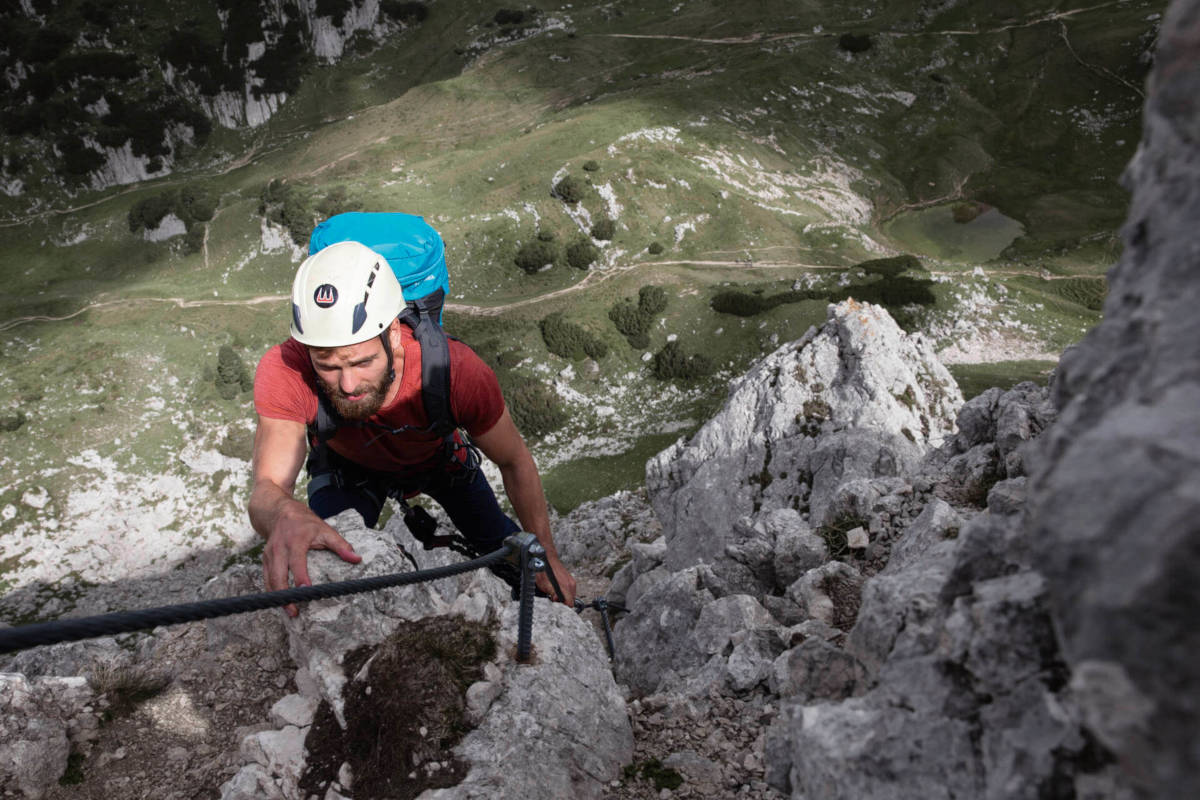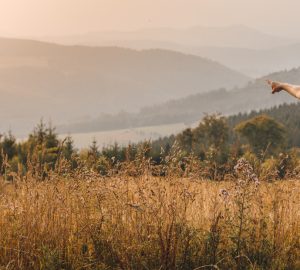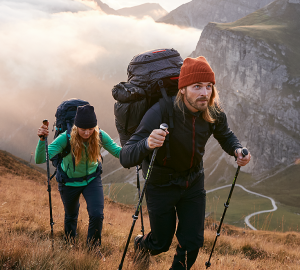Via ferrata tours are more popular than ever: Only a few years ago belittled as “pseudo-mountain climbing”, they are currently experiencing a real boom. The reason for this is the variety and intensity of the outdoor experience that these tours with their often exposed routes have to offer. Tatonka staff members Michi Bösiger and Ralf Karlinger present two of their favorites.
Unique outdoor adventures in airy, sometimes dizzy heights are the promise of via ferrata tours that can offer really special challenges to mountain lovers and outdoor sport enthusiasts: They always demand willingness to take a risk, whether great or small, and physical exertion, whilst at the same time providing the reward with splendid views.
Beginners and people new to rock climbing can learn to climb via ferrata routes easily and can practice and gradually improve and expand their skills; the various levels of difficulty are attractive to beginners and newcomers just as much as to experienced mountain fans and absolute experts “in the vertical”.
The appeal of the via ferrata lies in their contrasts and extremes: Difficult passages on vertical slopes interchange with more comfortable tour sections, although these may be equally exposed; some tightrope walks demand a balancing act, others invite you to a relaxing march. Some can be mastered comfortably by families, others present major challenges even to the fittest sportsmen.
The extent and variety of the via ferrata spectrum are demonstrated by the tour tips of Tatonka field staff Michi Bösiger and Ralf Karlinger: An easy via ferrata that is technically easy to master, but that nevertheless presents certain challenges by reason of its spectacularly exposed passages and a more sporty tour with higher levels of difficulty and varying sections.
Good to know: Basic knowledge of via ferrata for beginners – Safety on the precipice: Tips for a safe via ferrata tour
Pinut: Historic via ferrata in Switzerland attracts beginners to the rope
Splendid views and exciting stages – the via ferrata Pinut in Flims: Tatonka staff tried it out, and Michi Bösiger recommends this tour; the level is quite low and suitable for beginners and families with children (12 years old +). The walk up the Pinut, however, is not easy, although categorized as A to B the route nevertheless demands certain security measures.
Flims is situated about 20 minutes by car from Chur and 90 minutes by car from Zurich. By car the Pinut is reached via the A3/A13 to Chur. On your approach route via the San Bernardino, then take the exit Reichenau. For all via ferrata lovers who come via Lukmanier or Oberalp pass, this is a journey with impressive panorama views. You can travel comfortably to Chur by train or to Ilanz where you change to the “Postauto” (Mail Car).
Pinut looks back over many years of history: It was mentioned for the first time in the mid 18th century. For many years the local farmers used the terraces of the Filmserstein as meadowland. At the beginning of the 20th century, the Pinut became a tourist attraction but only a few decades later it was then forgotten. In 2005 the climb had to be closed for safety reasons. In the course of renovation in 2007 a new approach was added whereby there is a new route around the freestanding milestone whereby the dangerous ravine can be avoided.
In technical terms the Pinut does not present any major challenges to mountain lovers (Level of difficulty A-B): Steps and other facilities enable ascent via a total of twelve sets of ground hoops and including three almost vertical rock faces across the Pinut and Pardatsch.
The Pinut is not for persons of weak nerves: The via ferrata leads through extremely exposed sections but is thus able to provide breathtaking views at dizzying heights down to the ground below. Once the via ferrata climber has passed the small cavern and the narrow gorge, then he reaches the Pinut terrace with a splendid panorama view of the valley and the villages of Flims and Laax.
The next phase is via a steep serpentine track to the next rock outcrop: via rock wall and another very steep ascent, the route leads to the expansive, rich meadowlands of the Flimserstein – a place to rest and enjoy the panorama views. This wonderfully impressive tour ends with the picturesque descent to Bargis.
Also interesting: Via ferrata to the sky – On iron stairs to heaven
Hiking times for the ascent
- from Flims village to Fidaz Milchseilbahn: approx. 45 min
- from Fidaz Milchseilbahn to the entrance: approx. 30 min
- from historic via ferrata Pinut to Servetsch Pinut: approx. 2:20 h
- from Servetsch Pinut to Cassons: approx. 2:45 h
Hiking times for the descent
from Servetsch Pinut to Bargis: approx. 1 h
- from Bargis to Fidaz: approx. 1 h
- from Fidaz to Flims village: approx. 35 min
- from Cassons to Flims village (by rail): approx. 45 min
Drachenwand Via Ferrata in Austria: Sporting challenge with breathtaking panorama view
TATONKA employee Ralf Karlinger recommends the popular Drachenwand via ferrata at lake “Mondsee” in Upper Austria. At the weekends there are often very many people here and so, if you decide on this unique via ferrata, you should take two days free in the week.
From May to October in good dry weather this via ferrata is good for walking; in rain it is not passable. Most stages are moderate (level of difficulty mostly B), some passages, however, demand strength, surefootedness, endurance and concentration, (level of difficulty: C, sometimes D). The entire via ferrata is well secured with steel cables, ladders and stepping rods. Here too of course, full mountain gear with helmet and gloves is essential.
The lake Mondsee and the Drachenwand via ferrata are not far from Salzburg. Take the West Highway to the Mondsee exit and drive along the west bank of the lake to Gries. Here you turn right in the direction of St. Lorenz until you come to Gasthof Drachenwand (a traditional inn with excellent regional cooking). Just leave your car here. From now on you follow the hiking route in the direction of Drachenwand.
The approach route to the via ferrata is on the west bank of Lake Mondsee and is easily reached.
Tip: Take your bathing clothes with you and after a strenuous ascent and in part a difficult descent, you can take a refreshing plunge into the lake. This varied via ferrata route climbs to over 560 meters. It is an exciting mixture of challenges coupled with comparatively uncomplicated and “relaxing” sections. The view down to the Mondsee is always present for climbers during their ascent, beginning with two ladders on the wall of approach.
The passage “Franzosenscharte” is a demanding route but definitely rewarded with exceptional views. Following on from the “Franzosenschanze”, a suspension bridge of about twenty meters in length connects an exposed pillar with the steep rock face – a short stage but a spectacular experience, with a guaranteed thrill! After this, a broad, rocky face leads to the summit. Here you have an absolutely incomparable panorama view over the lakes below and the saddle massive – your unique reward for all your efforts to get here.
The descent from the Drachenwand via ferrata also holds a few surprises: The descent contains a second ascent and for comfortable and safe mountain descent you should have hiking sticks. If it is raining, the descent can be very tricky. On this tour in general there are always warnings about the increased risk of rock fall. This is also a reason that you should never wander away from the official via ferrata route
Hiking times
- Walking time: 4 hours
- Approach: approx. 30 minutes
- Ascent: 2 hours
- Descent: 1.5 hours
- Difference in height: via ferrata: 400 m, total: 560 m







